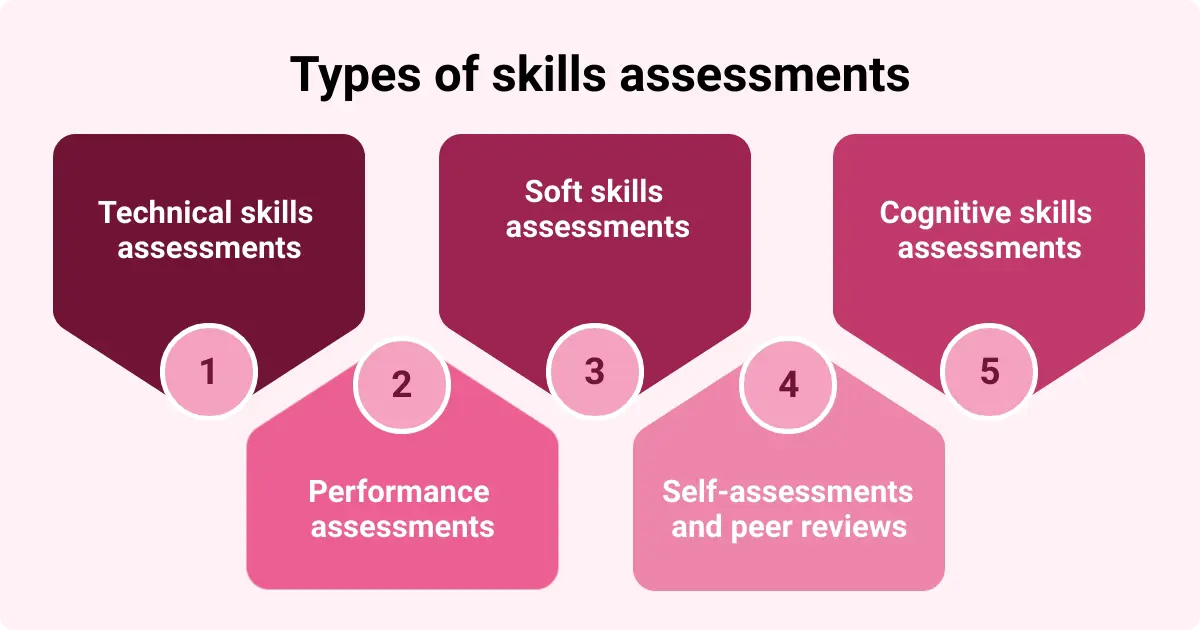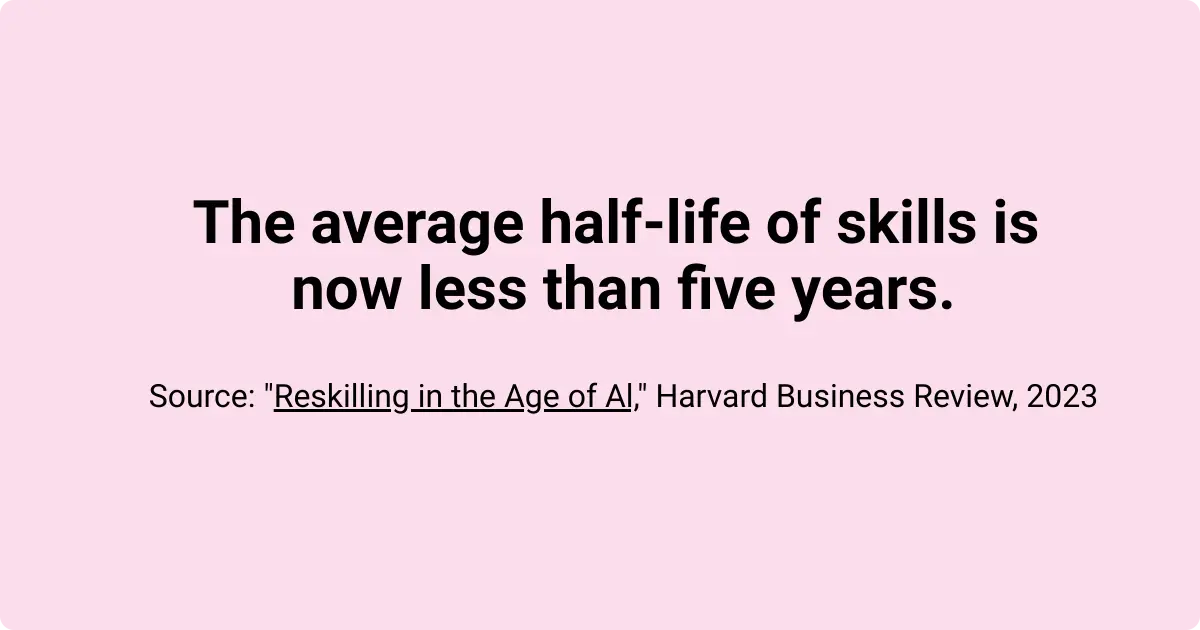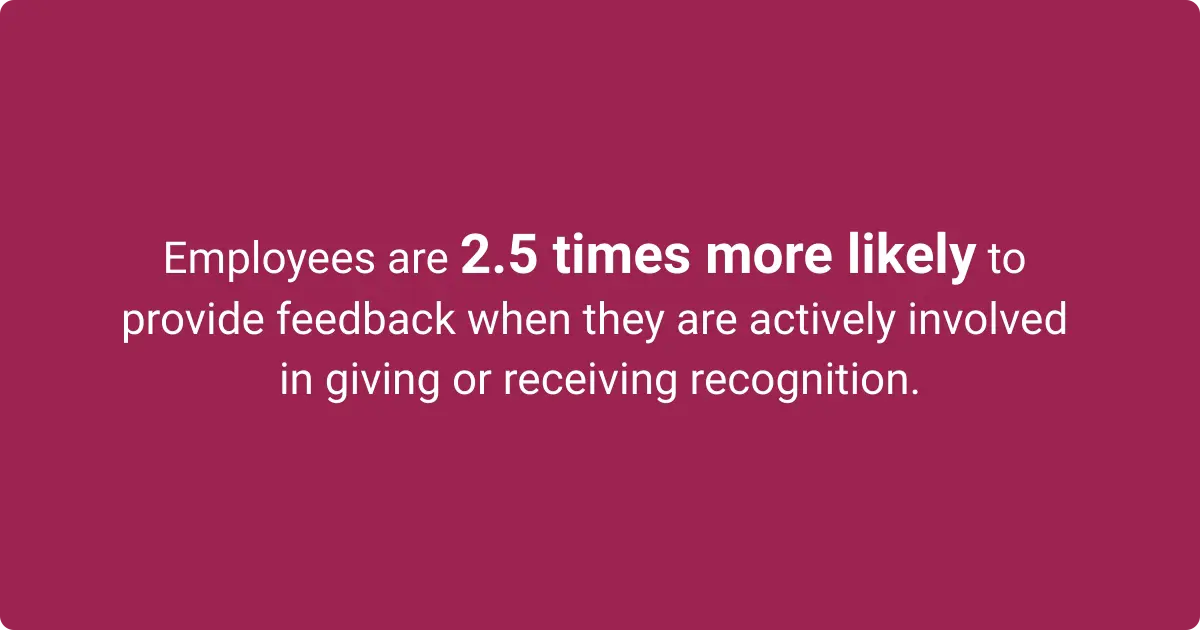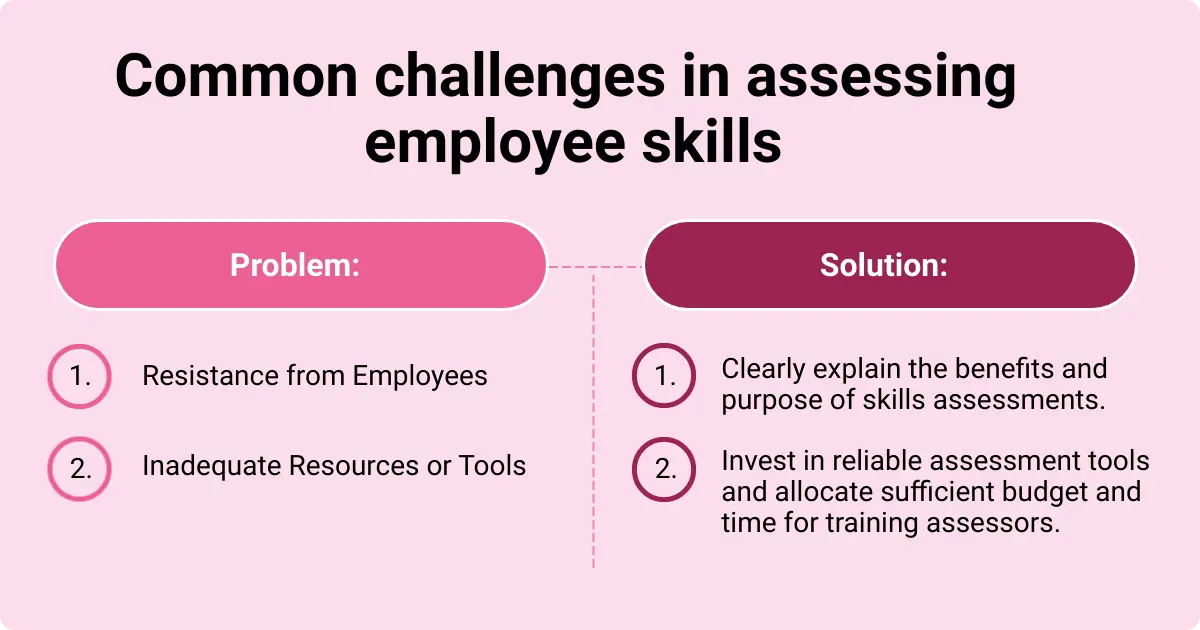Unlock Your Team's Potential: Mastering the Employee Skills Assessment for Peak Performance
Table of contents

Assessing employee skills is no longer optional in today’s dynamic work environment; it's essential. An employee skills assessment provides a clear picture of your workforce's capabilities, facilitating targeted development and growth.
Skills assessments are integral for both organizational advancement and personal employee development. With the rise of AI and automation, 75% of organizations are now embedding AI into their HR operating modelsOpens in a new tab, as revealed by Aptitude Research.
This shift underscores the importance of continually assessing and updating employee skills to meet the evolving demands of the workplace.
In this article, you'll learn effective strategies for implementing employee skills assessments, understand their importance, and discover best practices that HR managers and business leaders can adopt to enhance productivity and engagement.
Understanding employee skills assessments
What is an employee skills assessment?
An employee skills assessment is a systematic process of evaluating employees' skills, abilities, and knowledge to determine their proficiency and identify areas for improvement. This structured approach helps organizations measure their workforce's competencies against job requirements and organizational goals.
The purpose of an employee skills assessment is multifaceted. Its primary focus is ensuring employees possess the necessary skills to perform their roles effectively.
By identifying skill gaps, organizations can tailor their training and development initiatives to address specific needs, fostering continuous improvement and growth.
Additionally, skills assessments aid in career planning, succession planning, and optimizing team performance, ultimately driving organizational success.
You might also like: Understanding the Importance of Skills Mapping in Your Organization
Types of skills assessments

Imagine building a house. You wouldn't rely on just a hammer to do all the work – you'd need a variety of tools to ensure every aspect of construction is covered. Similarly, assessing employee skills requires multiple approaches to get a comprehensive view of their capabilities. Here are the key types of skills assessments:
Technical skills assessments
These assessments focus on skills profile related to job-specific technical abilities. For example, coding tests for software developers or mechanical skills tests for engineers. They ensure employees have the hard skills necessary to perform their technical roles effectively.
Soft skills assessments
Soft skills assessments evaluate interpersonal and communication skills, emotional intelligence, teamwork, and leadership abilities. These might include situational judgment tests or behavioral interviews. Soft skills are crucial for roles that require strong collaboration and leadership.
Cognitive skills assessments
Cognitive skills assessments measure problem-solving abilities, logical reasoning, and critical thinking. Aptitude tests and cognitive ability tests fall into this category. These assessments help identify employees who can think on their feet and tackle complex problems.
Performance assessments
Performance assessments involve observing and evaluating employees performing actual job tasks. Work simulations and practical exams are common methods. This type of assessment provides a real-world view of how employees apply their skills on the job.
Self-assessments and peer reviews
Self-assessments and peer reviews allow employees to evaluate their skills and receive feedback from colleagues. Tools like 360-degree feedback provide a holistic view of an employee’s performance and areas for improvement, fostering a culture of continuous development.
Feedback and peer evaluation can only be effective when they catalyze learning and growth. Learn how to leverage peer feedback for growth and development.
Examples of skills assessments in various industries
Assessing skills in various industries is like using the right tools for different jobs – just like you wouldn't use a wrench to paint a wall, different sectors require different assessment methods. Here are some spot-on examples:
Technology sector
- Coding bootcamps: Think of these as tech boot camps where participants get tested with coding challenges and project-based assessments, much like training for a marathon with sprints and long runs.
- Continuous skills evaluation: Platforms like HackerRank keep tech professionals sharp, like a digital gym for your coding muscles.
Healthcare
- Clinical skills assessments: Nurses and doctors undergo simulations and practical exams to ensure they can handle medical emergencies as smoothly as they handle a stethoscope.
- Competency evaluations: Regular evaluations are their check-ups, keeping their skills in top-notch condition for ongoing certification.
Manufacturing
- Technical skills tests: Assessments for machinery operation and safety protocols are like the driving tests of the manufacturing world, ensuring employees can navigate their equipment with precision.
- Hands-on assessments: Quality control and production efficiency are evaluated through practical tests, like a taste test, but for products.
Sales and marketing
- Role-playing scenarios: These scenarios test negotiation and sales techniques, much like a rehearsal dinner for the big sales pitch.
- Marketing skill tests: Evaluations of campaign management and digital marketing strategies ensure marketers are up-to-date, like a refresh button for their skills.
Education
- Teacher evaluations: Classroom observations and student performance metrics provide insights into teachers’ effectiveness, like a report card, but for the teachers.
- Professional development assessments: Continuous assessments help educators stay current, keeping their teaching methods as fresh as the first day of school.
What are the benefits of conducting skills assessments?
Conducting skills assessments isn't just a box to check; it's a powerful tool for solving real problems and driving your organization forward. Here’s how:
- Improved productivity and efficiency: According to Mercer’s Global Trends Report, execs and employees both agree that too much busy work, not enough thinking time, and ineffective organizational structures are top productivity drains. Skills assessments help identify these gaps and streamline processes.
- Enhanced employee development and satisfaction: Upskilling and reskilling employees has become crucial, with the average half-life of skills now less than five yearsOpens in a new tab. Tailored development plans ensure employees stay relevant and engaged.

Learn more about effective reskilling strategies with AI-powered platforms and how to maintain a competitive edge in today's dynamic workplace.
- Better alignment of employee skills with organizational goals: Aligning skills with strategic objectives ensures the right talent is in place for future growth. Organizations that adopt technology-focused approaches to problem-solving are positioning themselves for higher growth.
- Enhanced organizational performance: A skills-powered approach drives overall organizational success by fostering a culture of learning and innovation.
Skills assessments are more than evaluations for employees; they're your strategy for a more robust, more capable workforce. With clear insights and targeted actions, you're not just keeping up; you’re setting the pace.
Designing an effective program to assess employee skills and competencies
Identifying key skills for your organization
Creating a robust skills assessment program starts with knowing what skills your organization needs. Let’s explore how to pinpoint those crucial abilities together—because great minds think alike, and so do we.
How to determine the skills needed for different roles
- Job analysis: Think of job analysis as the detective work of HR. By conducting thorough investigations - interviews, surveys, and direct observations - you can uncover each role's core responsibilities and tasks. It’s like solving a mystery, but instead of finding out whodunit, you’re figuring out what needs doing.
- Competency mapping: Imagine building a treasure map that leads to a chest full of essential skills, knowledge, and behaviors required for each role. Categorize these competencies into technical, cognitive, and interpersonal skills. X marks the spot where your employees shine.
- Industry benchmarks: Don’t reinvent the wheel. Compare your organization's roles and required skills with industry standards and benchmarks to ensure relevance and competitiveness. This keeps you on the cutting edge, not the rusty hinge.
- Consultation with stakeholders: Here’s where the magic happens. Engage managers, team leaders, and employees in identifying essential skills through collaborative discussions and feedback sessions. It’s like a brainstorming session but with fewer doodles and more actionable insights.
Utilizing job descriptions and performance data
- Detailed job descriptions: Think of job descriptions as the instruction manuals for each role. Ensure they are comprehensive and clearly outline the skills and qualifications required. Regularly update these descriptions to reflect any changes in job functions and organizational needs. Nobody likes outdated instructions.
- Performance appraisals: Performance reviews can be a goldmine of information. Analyze this data to identify skill gaps and areas for improvement for existing employees. It’s like looking at a highlight reel of what’s working and what’s not.
- Employee feedback: Don’t just take our word for it – ask your employees. Gather input on the skills they believe are essential for their roles. Surveys and feedback forms can help collect data on perceived skill gaps and training needs. It’s like crowdsourcing but for skills.
- HR analytics: Use HR analytics to identify trends and patterns in skill requirements and employee performance. These data-driven insights help prioritize skills that have the most significant impact on organizational goals. Think of it as having a crystal ball for workforce planning.
By systematically identifying critical skills, you can design an effective skills assessment program that aligns with both organizational objectives and individual career growth.
Choosing the proper assessment tools
Selecting the right tools for your skills assessment program is crucial. Think of it like choosing the right kitchen gadgets for a recipe – each one has a specific purpose and makes the process smoother. Here's an overview of various assessment tools to help you find the perfect mix:
| Assessment Tool | Purpose | Strengths | Weaknesses | Best For |
| Psychometric Tests | Assess cognitive abilities, personality traits, etc. | Provides deep insights into mental and emotional traits | Can be time-consuming and may require specialized interpretation | Understanding cognitive and emotional characteristics |
| 360-Degree Feedback | Collects feedback from peers, subordinates, and supervisors | Offers a comprehensive view of an employee’s skills and performance | Can be biased if not managed properly | Evaluating soft skills, leadership, and teamwork |
| Skills Inventories | Lists and matches employees' skills with job requirements | Keeps a comprehensive and up-to-date record of employee skills | Requires regular updates and maintenance | Matching skills with job requirements |
| Work Samples and Simulations | Practical tests for job-related tasks and problems | Direct assessment of technical and job-specific skills | It may not fully capture everyday job complexity | Assessing technical skills and competencies |
| Behavioral Assessments | Evaluates behavior in various scenarios | Effective for assessing soft skills and real-world responses | Can be subjective and may need skilled interviewers | Evaluating communication, decision-making, leadership |
| Learning Management Systems (LMS) | Online assessments and training modules | Tracks progress and provides ongoing data on skill development | Requires technological infrastructure and may involve a learning curve | Continuous skill development and tracking |
Psychometric tests
Assess cognitive abilities, personality traits, and other psychological characteristics. Common tests include aptitude tests, personality questionnaires, and emotional intelligence assessments. These tools help you understand your workforce's mental and emotional landscape - like reading their minds, but without the spooky vibes.
360-degree feedback
Collect feedback from an employee’s peers, subordinates, and supervisors to provide a comprehensive view of their skills and performance. This method is useful for evaluating soft skills, leadership abilities, and teamwork. It’s like getting reviews from all angles, ensuring no stone is left unturned.

Skills inventories
These are comprehensive lists of employees' skills used to match skill sets with job requirements. Often maintained in HR databases and regularly updated through assessments, skills inventories are like your organization’s talent treasure chest, ready to be opened when needed.
See also: Talent Marketplaces: Unveiling New Avenues for Skills Matching
Work samples and simulations
Practical tests where employees perform tasks or solve problems related to their job. Effective for assessing technical skills and job-specific competencies, these assessments are the “show me” part of the equation—because seeing is believing.
Behavioral assessments
Use structured interviews and situational judgment tests to evaluate how employees behave in various scenarios. Focus on soft skills such as communication, decision-making, and leadership. Think of it as capturing your employees' responses in action, like a candid camera moment, but for professional skills.
Learning management systems (LMS)
Platforms that offer online assessments and training modules. LMS can track progress and provide data on skill development over time. It’s like having a personal trainer for your employees’ skills, guiding them and monitoring their growth.
How do you implement an employee skills assessment?
Assessing an employee's skills effectively requires careful planning and execution. It’s about setting the stage for success by ensuring every step is thought out and communicated clearly.
Here’s how to get started:
Preparing for the assessment
Communicating with employees
- Initial announcement: Clearly explain the purpose and benefits of the skills assessment to employees. Emphasize how the assessment will help both the organization and individual career development.
- Information sessions: Hold meetings or webinars to provide detailed information about the assessment process. Allow employees to ask questions and address any concerns they may have.
- Written communications: Send detailed emails or memos outlining the assessment schedule, tools, and expectations. Provide resources such as FAQs, guides, and contact information for further assistance.
- Regular updates: Keep employees informed about the progress of the assessment process through regular updates. Use newsletters, intranet posts, or team meetings to share important milestones and next steps.
Setting clear objectives and expectations
- Defining goals: Clearly define the objectives of the skills assessment (e.g., identifying skill gaps, informing training programs). Align assessment goals with organizational priorities and strategic objectives.
- Setting expectations: Outline what is expected from employees during the assessment process, including participation and timelines. Explain how the assessment results will be used and ensure confidentiality.
- Providing guidelines: Offer clear guidelines on how employees can prepare for the assessments. Share examples of the types of assessments they will encounter and any preparatory materials.
- Establishing a timeline: Develop a detailed timeline for the assessment process, including key dates and deadlines. Ensure that the timeline is realistic and allows sufficient time for preparation and completion.
Conducting the assessment
Step-by-step guide on administering different types of assessments
- Preparation phase: Ensure all assessment tools and resources are ready and accessible. Train managers and assessors on how to administer the assessments effectively.
- Technical skills assessments: Set up practical exams or work simulations that reflect actual job tasks. Provide clear instructions and criteria for evaluation.
- Soft skills assessments: Use behavioral interviews, situational judgment tests, or 360-degree feedback surveys. Ensure that assessors understand the behavioral competencies being evaluated.
- Cognitive skills assessments: Administer aptitude tests, problem-solving tasks, or logical reasoning exams. Ensure a quiet, distraction-free environment for test-takers.
- Self-assessments and peer reviews: Distribute self-assessment forms and peer review surveys to relevant employees and provide guidance on how to complete these assessments honestly and constructively.
- Collecting results: Ensure all assessment data is collected securely and accurately. Use digital platforms or HR software to streamline data collection and storage.
Ensuring fairness and consistency in the assessment process
- Standardization: Use standardized assessment tools and criteria to ensure consistency across all evaluations. Develop clear scoring guidelines and rubrics to minimize subjectivity.
- Training assessors: To ensure consistency, train all assessors on the assessment tools and scoring criteria. Provide examples and practice sessions to calibrate assessors’ evaluations.
- Bias mitigation: Implement measures to reduce biases in the assessment process (e.g., anonymous evaluations, diverse assessor panels). Regularly review and adjust the process to address any identified biases.
- Feedback mechanisms: Establish mechanisms for employees to provide feedback on the assessment process. Use this feedback to continuously improve the assessment program.
Implementing skills assessments thoughtfully can lead to significant benefits for both employees and your organization. Clear communication, well-defined objectives, and a structured approach ensure a smooth and effective assessment process, paving the way for targeted development and improved performance.
Analyzing and utilizing assessment data
You've gathered the data – now what? Let’s turn those numbers and feedback into actionable insights that drive real improvements. Here’s how to crack the code:
Interpreting assessment results
To analyze assessment data, start with quantitative methods like statistical analysis to identify trends and patterns in numerical scores. This helps highlight overall strengths and weaknesses. For qualitative data, like open-ended responses, dive into content analysis. It’s like eavesdropping on a conversation to pick up the juiciest insights.
Comparative analysis is your way of seeing who’s sprinting ahead and who needs a boost. By comparing different departments or teams, you can spot where support is needed. Benchmarking against industry standards? That’s your reality check to see how you stack up.
Identify strengths by recognizing areas where employees perform exceptionally well, which can motivate continued excellence. Needs-based analysis helps identify skill gaps, prioritizing those that have the greatest impact on performance. Tailored feedback based on individual assessment results pinpoints specific areas for improvement.
Creating development plans
Creating an employee development plan is like crafting a personal growth recipe. Use assessment data to tailor these plans, addressing specific skill gaps with precision. Align these plans with role-specific needs and recommend training programs, workshops, or online courses that hit the sweet spot.
Mentorship and coaching are essential. Pair employees with mentors who have complementary skills, using assessment data to make effective matches. Regular check-ins are the checkpoints to review progress and tweak plans as needed, providing that much-needed feedback loop.
Set SMART goals – Specific, Measurable, Achievable, Relevant, and Time-bound – to keep development on track. Balance short-term wins with long-term career goals, ensuring continuous growth. Track progress with regular assessments and be ready to adjust plans as things evolve.
When you analyze data and create targeted development plans, you ensure employees are aware of their strengths and areas for growth, fostering a culture of continuous learning and improvement.
Overcoming challenges when you assess employee skills
Implementing skills assessments isn’t without its hurdles, but these challenges can be effectively managed with the right strategies. Let’s look at some common obstacles and how to overcome them:
Common obstacles
- Resistance from employees: Employees may feel anxious or resistant to skills assessments, fearing negative repercussions or feeling overwhelmed by the process.
- Inadequate resources or tools: Organizations might struggle to provide the resources or tools needed to conduct comprehensive skills assessments effectively.
Solutions and best practices
- Strategies for overcoming resistance: To address resistance, communicate clearly about the purpose and benefits of skills assessments. Emphasize how these assessments help in personal and professional growth. Offer support and resources to prepare employees and ensure the process is transparent and fair.
- Ensuring the availability of necessary resources: Invest in reliable assessment tools and platforms, such as Conversations, that can streamline the process. Allocate budget and time for training assessors and for employees to complete the assessments. This ensures the assessments are thorough and impactful.

Did you know that 65% of HR executives are seeking better quality manager-employee check-ins for feedback and coaching?
Workhuman's Conversations® solution is the tool you need. Enhance your interactions for more meaningful and effective employee engagement. Click here to discover how Workhuman can transform your feedback process.
Conclusion
Implementing effective employee skills assessments is crucial for organizational growth and personal development. By understanding and evaluating key competencies, creating tailored development plans, and overcoming common challenges, you can foster a culture of continuous improvement.
Technological advancements like AI and machine learning, along with the evolving needs of a remote and global workforce, will shape the future of skills assessments. Staying ahead of these trends ensures your organization remains competitive and your employees thrive.
Embrace these best practices to build a capable, resilient workforce ready for tomorrow's challenges.
About the author
Ryan Stoltz
Ryan is a search marketing manager and content strategist at Workhuman where he writes on the next evolution of the workplace. Outside of the workplace, he's a diehard 49ers fan, comedy junkie, and has trouble avoiding sweets on a nightly basis.